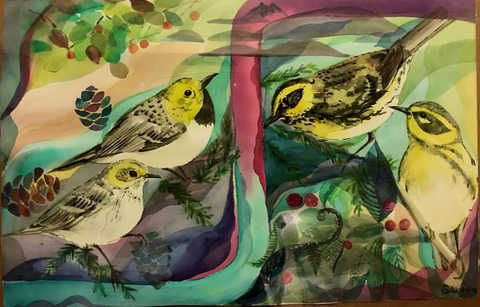Congratulations to lead author Dr. Silu Wang who has published another excellent paper on the hybrid zone between two beautiful warbler species, Setophaga occidentalis (Hermit Warbler) and Setophaga townsendi. Here is Silu’s beautiful painting inspired by the hybrid zone:

Silu and I are grateful to the contributions of coauthors Sievert Rohwer, Devin de Zwaan, David Toews, Irby Lovette, and Jacqueline Mackenzie.
The full citation:
Wang, S., S. Rohwer, D.R. de Zwaan, D.P.L. Toews, I.J. Lovette, J. Mackenzie, and D. Irwin. 2020. Selection on a small genomic region underpins differentiation in multiple color traits between two warbler species. Evolution Letters, online Early View; https://doi.org/10.1002/evl3.198
The abstract:
Speciation is one of the most important processes in biology, yet the study of the genomic changes underlying this process is in its infancy. North American warbler species Setophaga townsendi and Setophaga occidentalis hybridize in a stable hybrid zone, following a period of geographic separation. Genomic differentiation accumulated during geographic isolation can be homogenized by introgression at secondary contact, whereas genetic regions that cause low hybrid fitness can be shielded from such introgression. Here, we examined the genomic underpinning of speciation by investigating (1) the genetic basis of divergent pigmentation traits between species, (2) variation in differentiation across the genome, and (3) the evidence for selection maintaining differentiation in the pigmentation genes. Using tens of thousands of single nucleotide polymorphisms (SNPs) genotyped in hundreds of individuals within and near the hybrid zone, genome‐wide association mapping revealed a single SNP associated with cheek, crown, breast coloration, and flank streaking, reflecting pleiotropy (one gene affecting multiple traits) or close physical linkage of different genes affecting different traits. This SNP is within an intron of the RALY gene, hence we refer to it as the RALY SNP. We then examined between‐species genomic differentiation, using both genotyping‐by‐sequencing and whole genome sequencing. We found that the RALY SNP is within one of the highest peaks of differentiation, which contains three genes known to influence pigmentation: ASIP, EIF2S2, and RALY (the ASIP‐RALY gene block). Heterozygotes at this gene block are likely of reduced fitness, as the geographic cline of the RALY SNP has been narrow over two decades. Together, these results reflect at least one barrier to gene flow within this narrow (∼200 kb) genomic region that modulates plumage difference between species. Despite extensive gene flow between species across the genome, this study provides evidence that selection on a phenotype‐associated genomic region maintains a stable species boundary.
To read a Twitter thread about the paper, click here.
To read Silu’s blog about this paper on the Evolution Letters website, click here.
